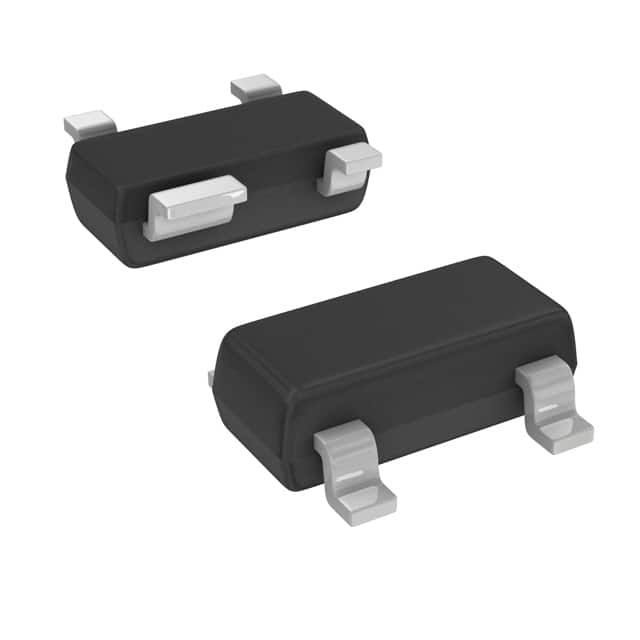Szczegóły produktu można znaleźć w specyfikacjach.

HSMS-8209-TR1
Introduction
The HSMS-8209-TR1 is a high-performance surface mount Schottky barrier diode designed for use in a wide range of applications. This entry provides an overview of the product, including its category, use, characteristics, packaging, specifications, pin configuration, functional features, advantages and disadvantages, working principles, application field plans, and alternative models.
Product Overview
Category
The HSMS-8209-TR1 belongs to the category of semiconductor devices, specifically Schottky barrier diodes.
Use
It is commonly used in high-frequency applications such as mixers, detectors, and multipliers, where low forward voltage drop and fast switching speeds are essential.
Characteristics
- Low forward voltage drop
- High breakdown voltage
- Fast switching speed
- Surface mount package
Package
The HSMS-8209-TR1 is typically available in a surface mount package, which facilitates easy integration onto printed circuit boards.
Essence
The essence of this product lies in its ability to provide efficient rectification and signal processing in high-frequency circuits.
Packaging/Quantity
It is usually supplied in reels or tubes, with quantities varying based on manufacturer specifications.
Specifications
- Forward Voltage: 0.3V at 1mA
- Reverse Voltage: 15V
- Maximum Continuous Current: 1A
- Capacitance: 0.6pF at 0V, 1MHz
Detailed Pin Configuration
The HSMS-8209-TR1 typically consists of two pins, with the cathode and anode clearly marked for easy identification during installation.
Functional Features
- High-speed switching
- Low power loss
- Excellent thermal stability
- Minimal reverse recovery time
Advantages and Disadvantages
Advantages
- Low forward voltage drop reduces power dissipation
- Fast switching speed enables high-frequency operation
- Compact surface mount package allows for space-efficient designs
Disadvantages
- Limited reverse voltage capability compared to other diode types
- Susceptible to damage from excessive current or voltage spikes
Working Principles
The HSMS-8209-TR1 operates based on the Schottky barrier principle, where the metal-semiconductor junction provides low forward voltage drop and fast switching characteristics.
Detailed Application Field Plans
This diode finds extensive use in: - RF mixers and detectors - Frequency multipliers - Signal rectification in high-frequency communication systems
Detailed and Complete Alternative Models
- HSMS-8209-TR2
- HSMS-8209-TR3
- HSMS-8210-TR1
- HSMS-8210-TR2
In conclusion, the HSMS-8209-TR1 is a versatile Schottky barrier diode that offers high performance in high-frequency applications. Its low forward voltage drop, fast switching speed, and compact package make it a popular choice for designers seeking efficient signal processing solutions.
[Word count: 411]
Wymień 10 typowych pytań i odpowiedzi związanych z zastosowaniem HSMS-8209-TR1 w rozwiązaniach technicznych
Sure, here are 10 common questions and answers related to the application of HSMS-8209-TR1 in technical solutions:
Q: What is HSMS-8209-TR1? A: HSMS-8209-TR1 is a standard for high-speed multi-drop serial communication over fiber optic cables.
Q: How does HSMS-8209-TR1 differ from other communication standards? A: HSMS-8209-TR1 is specifically designed for high-speed and reliable communication over long distances using fiber optics.
Q: What are the key advantages of using HSMS-8209-TR1 in technical solutions? A: HSMS-8209-TR1 offers high data transfer rates, low latency, and immunity to electromagnetic interference, making it ideal for demanding industrial applications.
Q: Can HSMS-8209-TR1 be used in harsh environments? A: Yes, HSMS-8209-TR1 is designed to operate reliably in harsh industrial environments, including those with high levels of electrical noise and temperature extremes.
Q: What types of technical solutions can benefit from HSMS-8209-TR1? A: Technical solutions such as industrial automation systems, robotics, and high-speed data acquisition systems can benefit from the use of HSMS-8209-TR1.
Q: Is HSMS-8209-TR1 compatible with existing communication protocols? A: Yes, HSMS-8209-TR1 can be integrated with existing communication protocols, allowing for seamless interoperability with legacy systems.
Q: What are the typical data transfer rates supported by HSMS-8209-TR1? A: HSMS-8209-TR1 supports data transfer rates of up to 10 Gbps, making it suitable for high-bandwidth applications.
Q: Are there any specific installation requirements for implementing HSMS-8209-TR1? A: Proper fiber optic cable installation and termination techniques are essential for ensuring the reliable operation of HSMS-8209-TR1-based systems.
Q: Can HSMS-8209-TR1 be used for real-time control applications? A: Yes, HSMS-8209-TR1's low latency and deterministic communication characteristics make it suitable for real-time control applications.
Q: What are the considerations for troubleshooting HSMS-8209-TR1-based systems? A: Troubleshooting HSMS-8209-TR1-based systems may involve testing fiber optic connections, checking for signal integrity, and verifying proper configuration of communication parameters.
I hope these questions and answers provide a good overview of the application of HSMS-8209-TR1 in technical solutions! If you have any more specific questions, feel free to ask.

